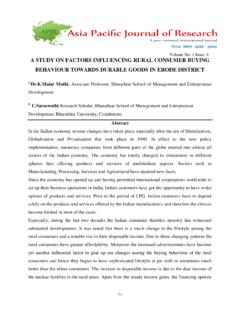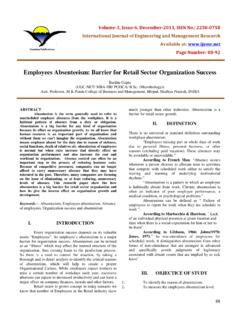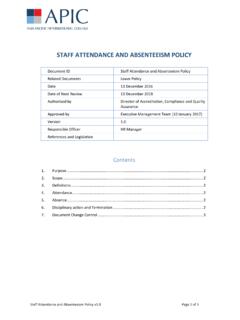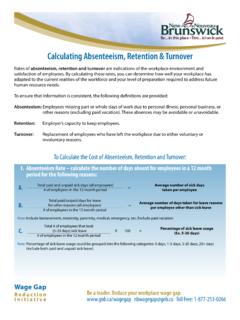Transcription of A STUDY ON ABSENTEEISM OF EMPLOYEES IN SELECTED …
1 A STUDY ON ABSENTEEISM OF EMPLOYEES IN SELECTED TEXTILE INDUSTRIES IN TIRUPUR DISTRICT OF TAMILNADU. * , ** Sivakami, Research Scholar, Assistant Professor, Department of Commerce, Department of Commerce, Karpagam University, Government Arts College (Autonomous), Coimbatore 6410 21, Tamilnadu, India. Coimbatore 641018, Tamilnadu, India. _____ INTRODUCTION ABSENTEEISM is one of the major threats to Indian industry. ABSENTEEISM causing poor utilization of plant India is facing unemployment problem on one side and the other side abnormal ABSENTEEISM in industries if our ABSENTEEISM can be reduced.
2 We can improve our gross national product without any investment. ABSENTEEISM not only causes production loss but also causes reduction of gross national income, when the gross income of workmen reduces naturally his buying capacity also reduces if he could not manage the primary and secondary needs of timely and properly. He has to face problems like poor family harmony poor health more mental and physical tiredness which will again lead to absenting from work. ABSENTEEISM as commonly understood refers to the failure of an operative to report to work when work is available to him as used in the STUDY overall ABSENTEEISM is made up of three component.
3 1) Leave sanctioned by management referred to in this report as authorized absence 2) Absence without any prior information to and permission from management referred to as unauthorized absence. 3) Certified sickness most widely knows as ESI leave. This does not include maternity leave absence of workers during strike due to lay off those o earned leave and women workers on maternity leave not have been considered as absentees. STATEMENT OF THE PROBLEM ABSENTEEISM is one of the great disasters faced by all the organizations in this modernized world which results in turnover.
4 So the firm has to reinvest so many amounts. People not only used to leave the organizations due to the personal reasons, the main reason is all about the industrial environmental factors ABSENTEEISM not only indicates the physical presence it starts with the Mental absence of an individual so the firm has to take this as a important issue before initiating any remedial actions through that and along with the participative management. All the textile industry is facing a significant problem on employee s regular attendance. There are so many factors that influence EMPLOYEES to take leave.
5 This STUDY ensures that it will reveal a clear good result for the absence. Due to absence of EMPLOYEES , the management is in compulsion to give target production. Generally, the textile industry is facing a tight competition all over the world. So the TEXTILE industry should have to take necessary steps and this also helps the management to know about the employee s basic needs which are not fulfilled and what the employee s expectation. OBJECTIVES To STUDY about the factors that influence ABSENTEEISM To know how the Private Textile industries deals with ABSENTEEISM .
6 By improving machine utilization by reduction of ABSENTEEISM the quality of product and productivity To STUDY about the working conditions prevailing in the market. LIMITATIONS Time is a important constraint and There may be a chance for sample error The observation and conclusion which are presented in the report is based on data collected only the sample EMPLOYEES of 10 private textile industries and cannot be generalized to other areas. The respondents may tend to disclose information unwillingly. RESEARCH METHODOLOGY POPULATION: The EMPLOYEES of ten textile industries in Tirupur district of Tamilnadu SAMPLE SIZE: The size of the sample SELECTED for the STUDY is 300 respondents.
7 RESEARCH DESIGN: A research design is the arrangement of conditions for collection and analysis of data in a manner that aims to combine relevance to the research purpose. It is a blue print of the STUDY . Descriptive research design was used in this STUDY for analysis. SAMPLE DESIGN: Convenient sampling was used in this STUDY , which does not afford any basis for estimating. It is a non-probabilistic sampling method. METHODS OF DATA COLLECTION In the STUDY the primary data was collected through structured questionnaire, the questionnaire was prepared in such a way that it covers the entire objectives of the STUDY and Secondary data are those which are collected from the magazines, booklets, etc.
8 FINDINGS Table No: 1 is found that 46% of respondents are getting 11000<14000 salary and 32% are getting 8000<11000, 17% are getting 14000<17000 salary and 5% of the respondents are getting 5000<8000 salary Table no: 2 is found that 19% of respondents are strongly agreed and 72% of respondents are of respondents is disagree about the job description. Table no: 3 is found that 80% of respondents are said that is conducted sometimes, 18% of respondents are said that is conducted rarely, 2% of respondents are said that it is conducted always about the performance appraisal Table no: 4 is found that 59% of respondents are agree with counseling facilities, 21% of respondents are strongly agree with counseling facilities, 19% of respondents are disagree with counseling facilities and 1% of respondents are strongly disagree with counseling facilities.
9 Table No: 5 is found that 61% of respondents are agree with job rotation, 20% of respondents are strongly agree with job rotation, 18% of respondents are disagree with job rotation and 1% of respondents are strongly disagree with job rotation. Table no: 6 is found that 57% of respondents are said that helpful, 26% of respondents are said that very helpful, 16% of respondents are said that indifference and 1% of respondents are neglected it. Table no: 7 is found that 63% of respondents are agreed, 20% of respondents are disagreed, 16 % of respondents are strongly agreed and 1% of respondents are strongly disagreed about the awareness of career planning Table no 8 is found that 62% of respondents are said that grievance handling are good,16% of respondents are said that grievance handling are fair, 15% of respondents are said that grievance handling are excellent and 7% of respondents are moderate.
10 Table no: 9 is found that 54% of respondents are said that working hours usually affects the morale of the EMPLOYEES , 33% of respondents are said that working hours sometimes affect the morale of the EMPLOYEES , 7% of respondents are said that working hours always affect the morale of the EMPLOYEES , and 6% of respondents are said that working hours rarely affects the morale of the EMPLOYEES . Table no: 10 is found that 55% of co workers are helpful, 33% feels that they are very helpful, 10% feels that they are indifferent and 3% feels that neglecting. 53% of respondents said that their team leaders are very helpful to them, 29% of respondents feels that they are very helpful, 13% of respondents feels that indifferent and 4% of respondents feels that neglecting Table no: 11 shows that 11% of respondents feel the work always lead to illness, 68% of respondents feel the work sometimes lead to illness and accident and 21% of respondents rarely lead to illness.









